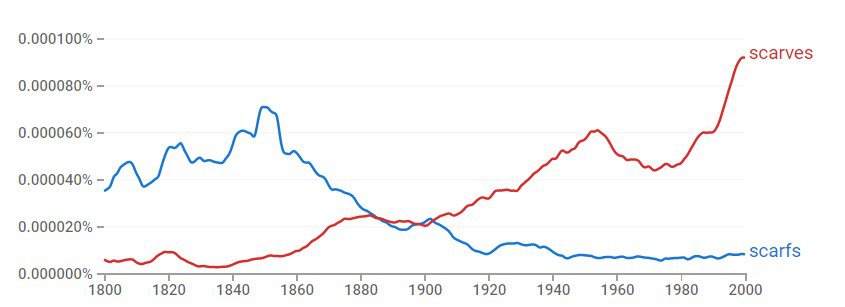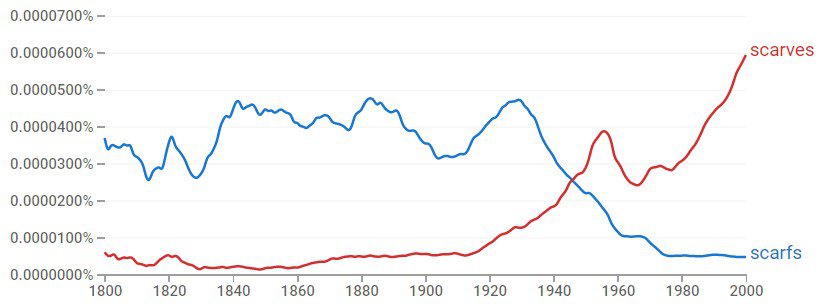Scarf has two plurals—scarfs and scarves. Scarves is the preferred form, but scarfs is the original and was more common before the 20th century. It’s still used, but only less than once for every 20 instances of scarves.
The switch probably happened by analogy with other words ending in f sounds.1 Wife, half, and leaf, for instance, are inflected wives, halves, and leaves, and likening scarf to these more common words is only natural.
Scarfs is also a simple-present inflection of the verb scarf in the sense to eat quickly and voraciously. The word is a newly formed American variant of a little-used British sense of scoff, 2 and it is usually embedded in the phrasal verb scarf down—for example:
When I give my dog a biscuit, he scarfs it down in half a second.
Examples
In books and periodicals published before the 20th century, scarfs is easier to find than scarves. Here are a few examples:
Having no other suitable way of distinguishing the sets, I marked, mine by tying round them little scarfs of black silk. [Omoo, by Herman Melville (1847)]
There were pall-bearers on horseback, with the richest scarfs and hatbands. [Middlemarch, by George Eliot (1874)]
Gem Miles appeared in uniform, rather striking in its contrast with the display of scarfs, bullion, and buttons on the full-dress uniforms of the court. [New York Times (1899)]
By the middle 20th century, scarves is more common, and today it prevails by a large margin. But scarfs, as a plural of scarf, still appears occasionally—for example:
But Ms Waite warned those who have been getting used to the warm weather to pack away their bikinis and sunblock for now and get out the coats and scarfs. [Sunday Express]
This mob wears matching powder blue shirts and scarfs. [University Daily Kansan]
And of course, it also appears as a form of the verb scarf, meaning to eat voraciously:
It scarfs down electricity like a football team at a hot dog eating contest. [NDTV]
Betty is clearly unhappy as she scarfs down her daughter’s leftovers (after finishing her own, of course). [Crave Online]
Ngrams
The below ngram graphs the use of scarfs and scarves in British books published between 1800 and 2019. It suggests the switch to the newer form happened just after 1900.

And this ngram, which graphs the words’ use in American books published in the same period, shows the switch happening a little later.

